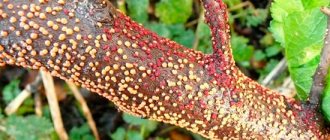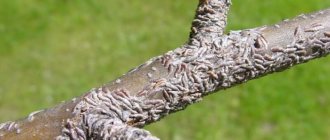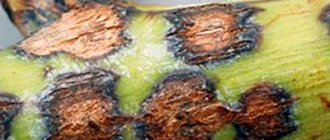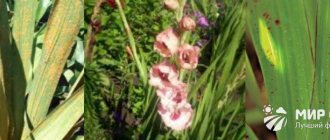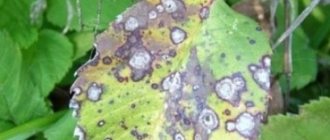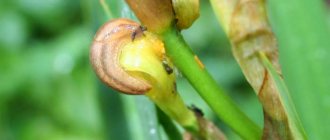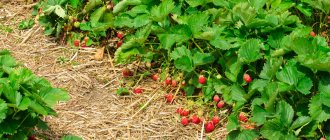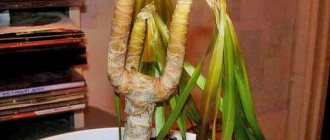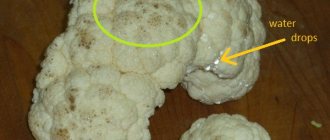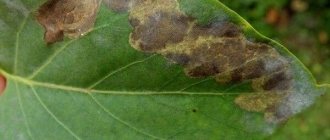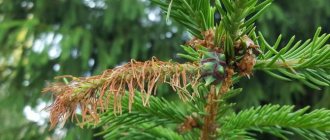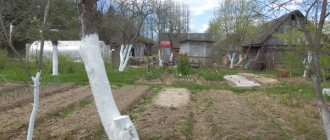Like most fruit trees, pears are sensitive to various diseases, viruses and fungi. Although breeders are constantly working on new varieties with enhanced immunity, the ideal is still unattainable. Therefore, it is better to prepare and study possible problems in advance. And most of them first appear on the leaves!
Pimples and tubercles on leaves
Such small defects do not appear on leaves very often, and this significantly limits the number of possible options. Most often it is a matter of pests or fungal spots.
— Phyllosticosis is a typical problem of pears and apple trees, which manifests itself in the form of brown, lumpy spots. Later, the affected leaves dry out and fly off;
— Small growths or galls remain on the leaves due to aphid infestation. While the eggs are developing, the adults drink all the juices from the plant;
— From a distance, scale insects on the leaves resemble small yellowish tubercles. But in fact, these are garden pests, because of which you can lose your luxurious crown in the future.
Fruit rot (Moniliosis) of pear
Fruit rot is caused by the fungus Monilia fructigena; small brown spots appear on the fruit.
Then growths appear on the pears, which contain spores. They are carried around by the wind, birds, and insects.
Photo of fruit rot (Moniliosis) of pear
The pulp of the affected fruits becomes less dense, tastes bland, and is extremely unpleasant both in appearance and in taste. Some pears affected by fruit rot may fall off, others mummify on the tree, falling off over time. Fungal spores scatter throughout garden plots, affecting other fruit plants.
You should know!
Fruit rot can develop most actively during hot and rainy periods.
Recommended preventive measures against pear moniliosis:
- regular sanitary pruning followed by treatment of the cuts with garden varnish. All cut parts must be burned immediately;
- in spring and autumn, it is recommended to treat trees with copper sulfate (1%).
If the first signs of disease are noticed on the pear, it is recommended to treat the pear with Khoma, Baikal, Actofit or Ecoberin solution. In mid-March and in the second ten days of November, the trunks and bases of the skeletal branches of the pear should be whitened with a solution of lime.
Currently, there is not a single pear variety that is absolutely resistant to this disease. But the most resistant to fruit rot are:
Cheremshina, Honey, Autumn Dream.
Leaves turn yellow and dry out
Yellow leaves on a pear tree are a double-edged sword, because on the one hand, it is the most common and not too frightening problem. On the other hand, there can be so many reasons for it that it is difficult to figure out the real one.
— In too dry a season, pear leaves turn yellow and dry out due to lack of moisture;
— After prolonged rains or due to overwatering, the spots slowly darken, soften and rot;
— If you water a pear in the middle of a sunny day and wet the crown, dry yellow burn spots may remain;
— Iron deficiency causes the leaves to turn yellow and dry out at the tips. Less commonly, similar symptoms are observed with calcium and magnesium deficiency;
— If yellow spots randomly cover the entire leaf, like a mosaic, it may be an incurable virus of the same name.
How to act
When identifying a disease, you should follow the following step-by-step instructions:
- Identify and recognize the type of disease.
- Carry out “treatment” of the tree with the source of infection.
- For preventative purposes, treat other stone fruits and pome trees in the garden.
- Notify your dacha neighbors and owners of neighboring plots about the possibility of the disease spreading and the need to take measures to prevent its outbreak.
- Treatment with chemicals must be carried out strictly according to the manufacturer’s recommendations, taking into account the timing and dosage of the component. This point is extremely important, since failure to follow the recommendations can lead to the harvesting of a potentially dangerous crop with pesticides that have not been removed.
Related article:
How to fight clubroot on cabbage
Brown spots on pear leaves
Red, red, brown, brown - these are only a small part of the shades of spots on pear leaves. But there is also an advantage - the more specific the problem looks, the easier it is to find the root cause!
— If you don’t care for it well and don’t thin out the crown on time, this is a sure way to the marsoniosis fungus with brown spots;
— Brown spots on the leaves appear if the pear is severely lacking copper. This occurs due to the lack of fertilizers or an imbalance in feeding;
— The main enemy of all garden crops is scab, which affects all parts of the tree and fruit. The leaves are covered with dark spots of a complex olive hue, which gradually turns brown;
— Rusty chaotic spots on the plates are a symptom of a fungal disease under the eloquent name “rust”;
— Due to septoria, complex two-color spots with a brown border and a whitish center appear on the leaves. Later, the light part may dry out, fall out or crack;
— Red spot or polystigmosis is one of a dozen varieties of fungal spots, but this time with bright red spots.
Why do pears get sick?
Pear diseases harm not only the fruits, but also the foliage, branches and root system. Ignoring the problem can lead to the death of the plant.
Diseases occur for several reasons:
- infection with various bacteria;
- fungal infection;
- infection with viral infections;
- improper care of the plant.
Disease-affected pear leaves.
Pear leaves turn black
Blackness is a much more alarming symptom, because it often indicates irreversible processes. Blackness is a sign of tissue necrosis and cancer of the pear.
— Young pears may turn black due to improper watering regime, because seedlings are sensitive to external conditions;
“The same consequences appear if you feed a young tree too much or too early with organic matter. It provokes burns of the root system;
— Black plaque on pear leaves is a symptom of sooty fungus, which successfully develops on the sweetish secretions left by aphids;
— Black leaves, inflorescences and shoots are a consequence of bacterial burn. The disease is most often spread by insects, as are many other viruses or bacteria;
— When affected by black cancer, the pear leaves first become covered with brown spots, and at the next stage black dots form on them.
Known diseases
If you find signs of bacterial, fungal and viral diseases on the pear, you should carry out a complete treatment of the garden. Many infections spread very easily - literally with a blow of the wind, so remote planting does not fully protect against problems. Regular prevention should be carried out in spring and autumn. Compliance with this rule is the key to success.
Attention! When treating plants in the garden with chemicals, pay attention to the expiration date of the active component of the drug. In the case of fruit trees, treatment is limited to harvesting - interventions are stopped at least 21 days before due to the risk of producing “poisonous” fruits.
Information about viral diseases can be found in the following video.
Fungal infections of pears
Pears are most susceptible to fungal diseases. Pathogens develop well and form powerful colonies in warm and damp conditions. Periodic pruning helps reduce the risk of spores spreading. The main cause of many diseases is the thickening of the crown.
Trees should not be placed in poorly ventilated areas. It is important to keep the ground under the fruit tree clean, promptly removing fallen leaves and fruits. They should not just be removed from the ground, but burned, and then the area should be dug up.
The cause of infection can be pests, so treatment in the spring with a complex of insecticidal and fungicidal preparations is most relevant.
Sooty fungus
This disease is also known by another name - yellow lichen. Appears as a noticeable dark coating. Spots similar to soot form on the leaf blades. They cover shoots and fruits.
Sooty fungus is actively observed at the stage of fruit formation. The pears themselves lose their presentation and are inferior in taste to healthy ones. If the problem is ignored for a long time, the growth rate of the crop changes, the development of shoots slows down, and the yield decreases.
If detected in a timely manner, the problem can be eliminated without chemical treatment. It is enough to take a damp cloth and remove the plaque with it. In this case, areas with massive lesions are removed and burned.
If the disease has spread significantly, it is impossible to do without the use of chemicals. Medicines for treating pears against sooty fungus:
- "Skor";
- "Strobe";
- "Horus";
- "Fury"
- "Shepra";
- "Decis".
Traditional methods are used to combat fungus. The shoots are wiped with a beer or alcohol solution. It’s interesting, but these methods work and show good results if all recommendations are followed.
Scab
The causative agent of pear scab is the fungus Venturia pirina. It shows its activity in conditions of high humidity. The first symptoms become noticeable with the onset of warm weather, and traces of the activity of the pathogenic organism can be seen on the underside of young leaves in late spring or early summer.
The danger is that the disease affects not only the leaf blades. It quickly spreads to shoots, flowers and fruits. It is necessary to carefully inspect the plants periodically.
If you ignore the problem and do not treat it, the tree will become covered with black-brown spots that resemble warts in appearance, which can merge into large areas of necrosis.
Attention! Looking at photos of pear leaf diseases, you can see some similarities between scab and phyllostictosis.
Most often, preparations containing copper are used to combat pear scab. The fungus quickly dies from contact with it. The main caveat is that these agents are contact agents; accordingly, the activity of the pathogen will be suppressed only at the site of the reaction where the component comes into contact with the spores.
Leaf rust
Rust is the most common damage to pears. Its symptoms appear sharply, and the state of the culture rapidly deteriorates. Noticeable tan (red) spots form on the surface of the leaves in spring. They grow quickly, darken and become covered with a gray-brown coating.
If you miss this phase, a growth or thickening will form on the back of the sheet. All the signs of this pear disease are visible in the photo.
Before starting an active fight against the disease, a “cleaning” is carried out. Remove all affected leaves and branches and then burn them. The soil around the plant is dug up. Further treatment is reduced to the use of systemic drugs - fungicides. Existing sections are treated with a solution of copper sulfate.
Cytosporosis
With this lesion, the bark on the branches of the plant quickly dries out, its shade noticeably changes, and gray bulges appear on the surface. The fungus is localized in them. The causative agent is Cytospora microspora.
In the spring, after the buds open, the affected branches and trees quickly dry out, and the infection itself remains in the bark.
It is very difficult to eliminate the problem, so it is better to initially follow the agrotechnical standards for growing pears on a personal plot. Trees must be protected from cytosporosis by regular treatments. If foci are detected, the affected areas are removed and burned, the plant is sprayed with a solution of Bordeaux mixture with a concentration of 1% or its analogues.
Fruit rot
Fruit rot or moniliosis is a dangerous disease that affects not only pears. It quickly spreads throughout the garden, affecting apple, cherry, sweet cherry, cherry plum and plum trees. Losses can be enormous, often reaching 80% of the total crop weight. The danger lies in the active spread of Monilla fructigena. Spores are carried by insects, as well as by rain and wind.
To combat the problem, biological, chemical and folk methods are used. The best results are achieved when using fungicides. The preparations “Horus” and “Skor” are effective, but processing the green mass alone is not enough. You can't do without watering. Fruits affected by rot must be disposed of.
Black cancer
Black cancer or Antonov's fire is a common and very dangerous fungal infection that appears on pome trees - apples and pears. The causative agent is Sphaeropsis malorum. The spores overwinter in fallen fruits and leaves, under healthy bark and remain active for 3-4 years.
Lesions cover the trunk, leaves, flowers and fruits. Infection of skeletal branches is considered dangerous. The bark of the tree in places where the fungus is active becomes stained, “charred” and cracks.
Next, the integumentary part dies off and the wood turns black. The diseased areas expand rapidly, dead tissue envelops the branches and trunk of the tree in a ring. First the shoots die, and then the whole pear.
Attention! Mature plants can be lost in just 3-4 years.
In the early stages (before looping), treatment is possible. The affected bark, including the healthy one, is cleaned and the area is disinfected with a solution of copper sulfate at the rate of 300 g of product per 10 liters of water. Next, the area is covered with garden varnish.
In case of a voluminous lesion, the area is “sealed” with putty made of clay and fresh mullein, mixed in a 1:1 ratio. This scheme can be used in early spring and late autumn, the air temperature should be about 13 degrees Celsius.
White spot
Septoria or white spot of pear is another common fungal disease that significantly reduces the plant's immunity. Against the background of its activity, frost resistance suffers, the tree weakens, and leaf fall begins early.
During the growing season, shoot growth decreases significantly. Lesions are most noticeable on young leaves. You can see the characteristic symptoms in the photograph.
Attention! Symptoms of septoria should be looked for on plants in May, when consistently warm weather sets in.
To eradicate the problem, treatment with fungicidal preparations is necessary:
- "Fundazol";
- "Skor";
- "Previkur";
- "Ordan"
- "Acrobat";
- "Oxychom";
- "Kuproksat";
- "Rovral";
- "Profit".
The first event is carried out before the buds open. Repeated treatment is planned after the growth of green mass, and the third - upon completion of flowering. One cycle does not guarantee complete elimination of the disease. It is better to alternate medications, changing the active substance.
Powdery mildew
The fungus Podosphaera leucotricha most often parasitizes apple trees, but can also affect pears. The symptoms are similar:
- a white coating appears on the inflorescences;
- shoots are deformed;
- leaves dry out;
- fruit formation decreases;
- At first, the coating is light and darkens over time.
To eliminate powdery mildew, fungicidal agents are used. Effective prevention is ensured by treatment at the beginning of the growing season - two sprays are enough. During treatment, treatments are carried out more often. The following drugs are used:
- "Tiovit";
- "Jet";
- "Raek";
- "Topaz";
- "Moon";
- "Horus."
The optimal interval between procedures is 1-2 weeks.
Phyllosticosis
The more common name for the disease is brown spot. Its occurrence is provoked by the fungus Sphaeropsidales. The lesion can be seen on the leaf blades. Dark brown or gray spots of indeterminate shape form on them. They are located remotely from each other and can later merge.
Noticeable black dots appear on the surface of the leaves. Peak spotting occurs in early summer. In conditions of warmth and moisture, active progress is possible.
For treatment, spraying with Bordeaux mixture or analogue drugs is carried out. It is not recommended to use compounds containing copper to combat the problem. They are ineffective and even dangerous. It is known from authoritative sources that such drugs can aggravate the course of phyllostictosis.
White coating on pear leaves
White plaque has only two origins - it can be mycelium and fungal spores, or the cobwebs left by some insects.
— The first and main reason is powdery mildew or the most common fungus that blooms on warm, humid days;
— Milky sheen is a disease of fruit crops, due to which the leaves appear dull, with a white-silver tint;
— Spider mites leave abundant white webs everywhere, which inexperienced gardeners confuse with ordinary spiders. But it becomes more and more, and small black insects appear on the leaves;
— The fruit moth most often affects apple trees, but also lives on pears. It eats all the pulp from the leaves down to the shell, and in the process of its life, it also leaves a whitish web.
Scab on a pear tree
Scab appears on pears quite often, and this disease affects foliage and fruits. As a result, the yield is often significantly reduced, and the tree itself is greatly weakened.
Photo of pear disease - scab
The causative agent of pear scab is the fungus Fusicladium pirinum.
The first symptom of the appearance of this disease is the appearance of olive-colored spots on the back of the foliage. These are the spores of this fungus.
When they appear on fruits, the following symptoms of scab appear:
- the pear becomes rotten and cracks;
- the pulp becomes too hard;
- when fruits are affected at the very beginning of their development, their deformation is noted.
Scab. Treatment and prevention - video
As a treatment, spraying with 1% Bordeaux mixture is used. Treatment with this drug is carried out several times per season:
after bud break, during budding, after flowering.
If treatments with Bordeaux mixture turned out to be ineffective, and the scab has not receded, then
you should spray the pears with one of the following preparations: Dnok, Skor or Nitrofen.
Photo of Bordeaux mixture
For preventive purposes, formative and sanitary pruning of pear trees should be carried out in a timely manner, without allowing the crown to thicken, in the fall, collect all remnants of vegetation and fallen leaves, and immediately burn everything outside the site.
Many gardeners recommend growing pear varieties that are highly resistant to scab:
- January;
- Muratovskaya;
- Rusanovskaya.
Pale and light leaves
If the leaves lose color, this is a sure sign of chlorosis, which also has completely different causes. There is a violation of agricultural technology and much more serious deviations in development.
- If a pear does not have enough nitrogen, it will not be able to grow strong and healthy green mass;
— When using spot fertilizers, it is easy to upset the balance of microelements, and this also affects the condition of the leaves. Therefore, it is recommended to take complex mixtures, especially for beginners;
- Chlorosis is caused by any violations of agricultural technology - excess or lack of sun, improper watering, sudden temperature changes. Young pears are especially sensitive, but most often after normalization of care they recover on their own;
— The fruit mite overwinters safely on a tree or in dry leaves, and in early spring drinks the juices from the nascent buds. The leaves bloom weak, faded and lethargic.
Bacterial infections
Bacteria are the simplest microorganisms that pose a considerable danger to fruit trees.
Infection most often occurs as a result of damage to the surfaces of the trunk, branches or foliage.
To prevent bacterial contamination, garden tools should be sanitized after each use.
Cortex cancer
The disease occurs when the pathogen Erwinia amylovora enters the plant's body. The first signs usually appear in early spring.
A characteristic sign of the disease is the death of the tree bark.
The buds, surface of the trunk and skeletal branches acquire a brown tint, and young branches begin to turn black and gradually dry out. The foliage becomes covered with black spots, and cracks appear along the edges. As a result, the tree becomes covered with blisters, begins to quickly rot, spreading a specific smell and dies.
To cope with the disease, it is necessary to spray with copper sulfate and azophos, and also trim the tree, taking at least 10 cm of healthy tissue. The cut areas should be covered with garden varnish.
What does pear bark cancer look like?
Root cancer
The disease occurs due to infection by the bacterium Agrobacterium tumefaciens stevens. Small smooth spots first appear on the rhizome, which over time become coarser and turn into cones. By autumn, these growths begin to rot and destroy the root system of the tree. Quite often, the disease affects young trees that grow in nurseries.
After the plant dies, the bacterium can remain viable for up to two years.
You can get rid of bacterial cancer by trimming the affected roots and disinfecting them with copper sulfate. After treatment with copper oxychloride, the rhizome should be rinsed with water.
Pear root cancer.
Bacterial burn
The bacterium that affects trees is often carried by insects. In addition, the pathogen can spread independently through the air.
The first symptoms of the disease are wilting and darkening of flowers, as well as curling and blackening of leaves. If measures are not taken in a timely manner, the disease will spread to the tree trunk . If the trunk is damaged, the tree cannot be cured and the only option is to remove the plant.
At the first signs during the growing season, it is necessary to treat the affected pear flowers and leaves with Streptomycin and drugs to strengthen the immune system.
Bacterial burn of pear leaves.
Sooty pear fungus
The most common pear disease, in which leaves and fruits turn black, is called sooty fungus (Fumago vagans Pers). First of all, trees with weakened immune systems and young specimens damaged by insects (in particular, aphids) are affected.
Symptoms : black sooty spots that may appear on the fruit, leaves or young branches of the tree.
Agrotechnical control methods : pest control, timely pruning, removal of affected fruits.
Biological products : Fitoverm (for minor damage).
Copper-based preparations : 3% Bordeaux mixture, HOM, Abiga-Pik, Indigo, Ordan, Oxychom.
Industrial fungicides : Diskor, Raek, Skor.
- All about aphids: types, photos, life cycle and methods of control
Tiny aphids can cause serious damage to plants. Let's find out more about this pest!
Other pests on pears and how to combat them
The following are other pests on pears and effective control of them, within which you can use specialized drugs.
Bukarka.
Bucarca Coenorrhinus pauxillus Germ . -a beetle 2-3 mm long, with an elongated curved black rostrum. The elytra are greenish-blue, with a metallic sheen; longitudinal punctate grooves are clearly visible on them. The larva is legless, 3 mm long, yellowish in color. The pupa is pale yellow, 2 mm long. Beetles overwinter in the top layer of soil. In early spring, beetles come to the surface, crawl onto trees and shrubs and feed first on buds, and then on buds and young leaves. Towards the end of the flowering of apple trees, females lay eggs, placing them one at a time in gnawed holes in the central vein or on the underside of the leaf. The female's fertility is up to 100 eggs. After 6-8 days, the larvae hatch and feed on the tissues of the petiole and veins, making longitudinal passages in them. Damaged leaves dry out and fall off.
If the pest population is large in June, massive leaf fall may occur, which greatly weakens trees and shrubs. Bukarka larvae continue to feed in fallen leaves, and in July-August they go into the soil to a depth of 4-10 cm, where they pupate. In September, beetles emerge from the pupae and remain for the winter. Larvae that do not pupate before September remain in the soil until the fall of the following year. Bukarka damages many fruit trees and berry bushes.
Control measures. Preventive spraying of all trees and shrubs in the garden in the spring, when buds open, with fufanon or its analogues (kemifos, karbofos) and again in June. Collecting and burning fallen leaves damaged by larvae.
Cherry pale-legged sawfly Priophorus pallipes Lep. (syn. P. padi L„ Cladius pallipes Lep.) - an insect 5-11 mm long, black, with light yellow legs and transparent wings. The larva has 7 pairs of abdominal legs, is grayish-green, with a dark olive back, sometimes with a reddish tint, and has 3 rows of white warts covered with hairs on each body segment. The head of the larva is light brown with a large black spot on the crown. The larvae overwinter in the soil, pupate there in the spring, and adult insects soon emerge. The female lays 4-10 eggs on the underside of the leaves along the central vein. After 8-9 days, the larvae hatch and skeletonize the leaves in small areas that resemble filmy-transparent windows. Older larvae eat round holes with smooth edges in the leaves. In moments of danger, the larvae curl into a ring and fall to the ground.
The larvae feed for about three weeks, after which they pupate in cobwebby, dense light brown cocoons in bark cracks and leaves. The flight of second generation insects is observed at the end of summer. The larvae of this generation, having finished feeding, go into the soil and overwinter. When in large numbers, the sawfly causes great damage to fruit trees and shrubs, especially cherry, pear, rowan, hawthorn, raspberry, etc.
Control measures. Spraying trees and shrubs immediately after flowering with the drug fufanon or its analogues (kemifos, karbofos) against a complex of pests also reduces the number of sawflies. If there are a large number of larvae at the end of summer and in September, spraying with the same preparations is carried out, taking into account the waiting time for each. Fitoverm, Kinmiks, Actellik, Inta-Vir are also used.
Slimy cherry sawfly
Slimy cherry sawfly Caliroa cerasi L. - a black shiny insect 4-6 mm long, with transparent wings with smoky shading in the middle part, yellowish shins. The larva is 9-11 mm long, greenish-yellow, covered with black mucus, the anterior edge is thickened. The mucus secreted by the larva smells like ink. The pupa is white, in a dense cocoon. A polyphagous pest that damages pome and stone fruit crops, it is widely distributed on rowan, hawthorn, rose hip, etc. The sawfly develops in 1-2 generations. The larvae overwinter in the soil, pupate there in the spring, and adult insects emerge at the end of May - June.
Females lay eggs on the underside of leaves. After 7-15 days, the larvae hatch, which are soon covered with mucus. The larvae skeletonize the leaves within 15-25 days. Having finished feeding, the larvae go into the soil and pupate in cocoons. Flight of the second generation of sawflies and egg laying are observed in late July - early August, and the development of larvae occurs until early October, when they go into the soil for the winter. The number of second generation larvae is always much higher and they damage leaves on trees and shrubs more severely.
Control measures. Spraying trees and shrubs with a large number of larvae with one of the following preparations: Fufanon, Kemifos, Actellik, Inta-Vir.
Mediterranean fruit fly
Mediterranean fruit fly Ceratitis capitata Wied . - a dipterous insect 4.5-7 mm long, with females larger than males. The color is variegated. The head is large, whitish-gray, with large red eyes with a greenish sheen. The chest is black with yellowish-white lines and spots, and there are white rings on the shoulders. The abdomen is yellow with two transverse lead stripes. The female has a thin, sharp ovipositor. The wings are wide with two transverse and one longitudinal smoky-gray stripes, the legs are ocher-yellow. Eggs are 0.7 mm long, curved, yellow, larvae are white, legless, 7-11 mm long.
The female pierces the skin of the fruit with her ovipositor and lays several eggs; the fertility of one fly is up to 800 eggs. The hatched larvae feed on the pulp of the fruit and, having completed development, emerge from the fruit after two to three weeks and pupate in the soil. After 7-10 days, flies hatch from the pupae and after fertilization, the females lay eggs.
Depending on weather conditions, 2-6 generations develop per year. The optimal air temperature for fly development is 20-28 °C; at a temperature of 12 °C, development stops. Fruits damaged by the fly rot and fall prematurely, and in large numbers the pest can completely destroy the fruit crop. The fly damages the fruits of citrus fruits, pome fruits, stone fruits, grapes, many vegetables, most often nightshades.
Control measures. Preventive spraying of gardens before flowering and immediately after flowering with fufanon or kemifos. If a fly is detected, spraying is repeated in the summer with the same drugs, taking into account the waiting period.
Pear leaf gall midge.
Pear leaf gall midge Dasyneura pyri Bouche. - a small pink-gray mosquito, 2-2.5 mm long, with delicate transparent wings and long antennae. The larvae are white, legless, spindle-shaped, which over time become orange-red and reach a length of 2-3 mm. Females lay eggs in the folded young growing leaves at the ends of the shoots; the hatched larvae feed on the sap of the tissues. The damaged edges of the leaves curl upward, forming dense tubes containing larvae. Development from egg to adult insect lasts 25-30 days and 3-4 generations develop per year. Over time, damaged leaves become yellowish-reddish, and in large numbers, young leaves at the ends of the shoots become underdeveloped and curl along the central vein.
Control measures. Preventive spraying before flowering and after flowering with one of the drugs: fufanon, kemifos, actellik, kinmiks, spark, Inta-Vir. If necessary, spraying is repeated in the summer with the same preparations, taking into account the waiting period.
Pear moth Laspeyresia pyrivora Danil. (syn. Carpocapsa pyrivora Dan.) a butterfly with a wingspan of 16-21 mm, very similar to the codling moth. The wings are dark gray, with transverse wavy stripes, darker at the base of the wing, and light gray in the middle part. At the top of the forewing there is an oval spot of silver or lead color (the apple has a bronze spot). The eggs are round, flat, red to pink-gray in color, with a dark red yolk visible through the shell. The caterpillar is 16-18 mm long, dirty white, with a yellow-brown head; on the abdominal legs there is a corolla of 11-17 short claws. The pupa is 11-13 mm long, dark brown, in a hard cherry-black cocoon.
Caterpillars overwinter in cocoons in the top layer of soil, in the spring they pupate there and butterflies emerge by the end of June. Butterflies fly at dusk, their flight continues for a month. After fertilization, females lay eggs on pear fruits, gluing them to the skin. After 7-8 days, the caterpillar hatches, bites into the fruit, makes a direct passage to the seed chamber and eats the seeds. All development and nutrition of the caterpillar occurs in one fruit and after 20-30 days the adult caterpillar makes a direct exit from the fruit, without leaving a wormhole, and goes into the soil.
At the point where the caterpillar emerges, fungal spores enter the wound and fruit rot develops. Often pear fruits are damaged by the codling moth, but it bites into the fruit through the calyx and fills the passage with red-brown excrement (wormhole), which the caterpillar of the pear moth does not do.
Control measures. Preventive spraying of fruit trees in the spring before flowering and immediately after it with one of the preparations: fufanon, kemifos, actellik, spark, kinmiks, Inta-Vir. The same preparations are sprayed directly against the codling moth 36-38 days after the end of pear flowering and again 12 days after the first spraying.
Frost leaf roller Exapate congela-tella Cl. - a small butterfly with pronounced sexual dimorphism. The male has developed wings with a span of 22 mm, the front wings are reddish or brownish-gray with a dark base and two round dark spots located in the upper part, closer to the anterior edge; the hind ones are gray or brownish-gray. The female has only underdeveloped fore wings, gray in color, covered with long thick dark hairs, and the hind wings are absent. The caterpillar is dirty green with lighter side stripes, dark or light spots, a yellow-brown head, sometimes with small dark dots. The chest shield is black or brown. Caterpillars damage the buds and leaves of fruit trees and berry bushes, as well as many deciduous trees.
Control measures. Preventive spraying of trees and shrubs in the spring, before flowering or immediately after it, with one of the drugs: Fufanon, Kemifos, Kinmiks, Actellik, caviar, Inta-Vir.
Autumn moth, or autumn moth Larentia autumnata Bkh., syn. Oporinia autumnata Bkh, is a gray butterfly with thin, delicate, developed wings. Body length 12-13 mm, wingspan 36-38 mm. The forewings are silvery-gray with numerous transverse wavy lines. The hind wings are ash-gray, lighter, with a faint transverse wavy line and clear dark longitudinal veins. The antennae are thin and long. The caterpillar is bright green, velvety, 25-30 mm long, lives and feeds in young leaves rolled up and held together by a web, which it gnaws at the edges. After finishing feeding, it goes into the soil, pupates and overwinters. The moth damages fruit and deciduous trees and shrubs. Distributed everywhere.
Control measures. Preventive spraying of bushes in the spring before flowering and immediately after it with one of the preparations: fufanon, kemifos, kinmiks, actellik, spark, Inta-Vir. If the pest population is large, spraying is repeated in the summer with the same preparations, taking into account the waiting period.
Gray pocket moth, or gray moth, or greenish bird moth Chloroclystis rectangulata L. , is a butterfly with a wingspan of 20 mm. The wings are wide, greenish-gray, have dark wavy transverse lines, the color varies greatly. The caterpillar is green with reddish longitudinal stripes on the back and a yellowish line on the sides, body length 15-16 mm. Older caterpillars overwinter in cobweb cocoons under leaves. In the spring they leave the cocoons and in April-May they actively feed, eating buds, flowers and leaves, lightly entwining them with cobwebs. On pome crops, caterpillars fasten leaves along the entire length from the petiole to the apex in the form of a pocket. In June, the caterpillars pupate, and at the end of June - July the flight of butterflies is observed. One generation of the pest develops. Severely damages apple, pear, bird cherry and many berry bushes.
Control measures. Spraying all fruit trees and shrubs in the spring, during bud break, with fufanon or its analogues (kemifos, karbofos).
Early dark gray armyworm Orthosia gracilis Schiff. (syn. Taeniocampa gracilis F.) is a butterfly with a wingspan of up to 52 mm. The forewings are reddish-brown with a gray tint. The ring-shaped and kidney-shaped spots are large, gray with light edges, the hind wings are light gray with a gray fringe and a gray central spot. The caterpillar is bluish-green, on the back there are 3 whitish lines and one yellow, on the sides there is a stripe bordered on top by black. The pupae are brown. The pupae overwinter in the upper layer of soil; butterflies emerge in the spring, the flight of which is observed from March to May. After fertilization, females lay eggs on budding buds and young leaves. The caterpillars feed and develop in June-July, after which they go into the soil and pupate. The armyworm damages pome and stone fruit crops, and causes particular harm to young trees in nurseries.
Control measures. Preventive spraying of gardens in the spring before flowering and immediately after flowering with one of the preparations: fufanon, kemifos, actellik, kinmiks, spark, Inta-Vir.
The pyramidal armyworm Amphipyra pyramided L. is a large brown-red butterfly with a wingspan of 50 mm. The forewings are dark brown, with light transverse lines and teeth, with black edges. The wavy line running across the wing is light with dark wedge-shaped spots. The ring-shaped spot is light with a dark center, located at the base of the wing. The hind wings are red-brown, brownish-gray at the anterior edge.
Caterpillar up to 50 mm long, green with a tint varying from yellow-green to bluish-green. The head is small, green, up to 3.5 mm in diameter. The body is thick, narrowed towards the head; on the eleventh segment of the abdomen there is a pyramidal protrusion of the same color as the whole body. Caterpillars gnaw leaves and fruit ovaries in May and until early June. They pupate from the beginning of June in loose white cobweb cocoons between leaves glued together with cobwebs. The flight of butterflies is observed from the end of July until autumn. Develops in one generation. The cutworm damages the leaves of fruit crops, forest deciduous trees, black currants, as well as pear fruits everywhere.
Control measures are the same as against the early dark gray cutworm.
Acronicta psi L. (syn. Apatele psi L.) is a butterfly with gray wings that have a span of 36-40 mm. The front wings have a brownish tint and black strokes at the base and on the outer field, the hind wings are gray-brown, darker at the edges. The caterpillar is black, up to 40 mm long, on the fourth segment it has a long, pointed bump, and on the eleventh segment there is a small tubercle, the back is light yellow, on the sides there are white-gray stripes with short red stripes, the leg line is white. The cone is covered with short black hairs, and the entire body is covered with sparse gray hairs. Butterflies fly in July-September, caterpillars feed on the leaves of fruit trees and shrubs, as well as deciduous trees.
Control measures. Collection and destruction of single caterpillars. In case of large numbers, spraying is carried out with one of the drugs: Fufanon, Kemifos, Kinmiks, Actellik, Inta-Vir, taking into account the waiting period.
The American bear Arctia villica L. is a large butterfly with a wingspan of 55-60 mm. The forewings are black, with eight large white spots, the hind wings are orange, with black spots near the outer edge and at the apex, sometimes merging into one large black spot. The head and chest are black, the abdomen is yellow-red, with three rows of black spots, black below, with a red longitudinal stripe.
The caterpillar is thick, black, with thick brown hairs and a dark red head. The pupa is black, in a white-gray cocoon. Caterpillars overwinter in the grass and under fallen leaves, pupate there in the spring, and butterflies emerge in June-July. After fertilization, the females lay eggs on the leaves, and the hatched caterpillars feed until autumn, gnawing on plant leaves. The shemale bear damages pome crops, raspberries, strawberries, yarrow, chickweed, and is often found on shrubs. The caterpillars are isolated and do not cause much harm.
Control measures. Catching butterflies using light traps; in case of a large number of caterpillars, spray with one of the following drugs: fufanon, kemifos, actellik, kinmiks, spark, Inta-Vir, taking into account the waiting period.
- Author: admin
Rate this article:
- 5
- 4
- 3
- 2
- 1
(26 votes, average: 4.1 out of 5)
Share with your friends!
Leaf rust
The causative agent of rust is the Pucciniaceae fungus.
It is this disease that often causes the tree to slowly die from wilting. If you do not deal with rust in a timely manner, the tree will die after a while.
Photo of the disease - Leaf rust
The first symptoms of the disease are spots of light yellow color appearing on the foliage and fruits, which gradually darken and acquire a rusty color, which is why rust got its name.
The spots appear immediately in large numbers, their sizes are small or medium, and can spread throughout the entire above-ground part of the pear or in a separate part in the early stages of the disease.
When the first signs of the disease are detected, it is necessary to collect all affected fruits and foliage from the trees, remove them from the site and burn them. And the pear trees themselves are treated with a 1% solution of a copper-containing preparation.
For preventive purposes, pears should be treated with Bordeaux mixture against rust twice a season - in the spring before the sap begins to flow and in the autumn, when the leaves have completely fallen. Usually, such treatments are quite enough to protect this fruit crop from rust.
Bordeaux mixture can be replaced with the systemic fungicidal drug Bayleton, which is quite effective in fighting rust, but pear trees will have to be treated with it at least 5 times during the period from April to October.
If rust has taken root in an area, it can be difficult to remove. It is recommended, in addition to treating the tree crown, to also spray the pear tree trunk with Urea. This treatment is carried out immediately before frost, and warm water is used to dilute the solution so as not to damage the roots. After such treatment, it is better to mulch the tree trunk circle.
Tree pests and their destruction
Orchid diseases: dark spots and other types of plant diseases and their treatment
Unfortunately, in addition to diseases, pears are often affected by harmful insects:
- Hawthorn butterfly. Destroys leaves, flowers and buds. It is better to get rid of in the fall - it is easier to find colonies of insects.
- Pear mite (gall mite). It settles in the buds, the larvae suck the juice from the young leaves. The crop's metabolism is disrupted, it grows and bears fruit poorly.
- Green apple aphid. It multiplies very quickly. All parts of the tree are sick, young branches may simply die. The pest is also a carrier of various fungi and bacteria.
- Pear psyllid (psyllid). A dangerous insect that sucks juice from leaves. The tree gradually stops developing and bearing fruit normally, and gradually dies.
- Leaf roller. This is a species of aphid that poses a serious threat. The insect can destroy the entire crop and cause the death of the plant.
Diseases and pests of pear require special attention, otherwise you may lose the crop.
